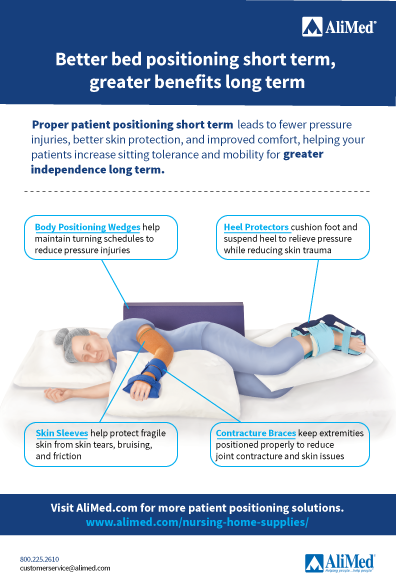-
Home
-
Proper Bed Positioning for Patients: The Long-Term Benefits
Proper Bed Positioning for Patients: The Long-Term Benefits
June 30, 2023

Download a printable poster here.
Patient positioning is one of the most frequently performed tasks in long-term care facilities, often due to the ongoing threat of pressure injuries. This is because bedridden or dependent residents who are weak, immobile, or medically or cognitively compromised cannot physically reposition themselves.
These residents are at a significantly higher risk of skin breakdown or other injuries caused by friction, shear, moisture, or pressure. The potential for pressure injuries poses a daily struggle for practitioners tasked with routinely turning or repositioning residents to help prevent complications.
Pressure injuries, also known as pressure ulcers or bed sores, occur frequently in healthcare facilities. If untreated, these injuries can lead to severe pain, discomfort, infections, and in extreme cases, death.
In this article, we will explore the costs associated with pressure injuries, the benefits of proper bed positioning, and useful medical devices designed to reduce the risk of pressure injuries and help relieve the burden of care on staff.
What is a Pressure Injury?
According to the National Pressure Injury Advisory Panel (NPIAP), a pressure injury is “localized damage to the skin and underlying soft tissue.” Bony prominences such as the elbow, tailbone, or heels are susceptible to pressure injuries. Skin damage can also occur due to pressure against the skin from a medical device.
Pressure injuries are typically assigned stages based on the severity of skin damage. NPIAP pressure injury stages include:
- Stage 1 Pressure Injury – Nonblanchable erythema of intact skin
- Stage 2 Pressure Injury – Partial-thickness skin loss with exposed dermis
- Stage 3 Pressure Injury – Full-thickness skin loss
- Stage 4 Pressure Injury – Full-thickness skin and tissue loss
- Unstageable Pressure Injury – Obscured full-thickness skin and tissue loss
- Deep Tissue Pressure Injury – Persistent non-blanchable deep red, maroon, or purple discoloration
The Economic Impact of Pressure Injuries
The development of pressure injuries can have a considerable economic impact on facilities. Such costs included increased care, length of stay, and overall burden on caregivers.
The following statistics compiled by the NPIAP illustrate the high rate of incidence and the economic impact of pressure injuries on healthcare facilities in the United States:
- Patients affected: 2.5 million per year
- Long-term care incidence rate: Nearly 12%
- Total costs: In 2007, costs were $11.6 billion and jumped to $26.8 billion in 2019
- Cost of individual patient care: $75,000 to $150,000 per injury stage 3 or greater
- Added cost to individual care: Up to $70,000 per incidence
- Medicare reimbursements: $0; hospitals are not reimbursed for “preventable” harms
- Lawsuits: Pressure injuries are the second most common malpractice claim after wrongful death; the average claim is $250,000, with settlements typically reaching over $1 million
- Death: About 60,000 patients die annually as a direct result of pressure injuries, making them one of the top 10 most frequent causes of death
More than half of all reported pressure injuries are late-stage. These more severe injuries require more time to heal or resources to care for them. And more resources mean higher costs for facilities and patients. These added costs may include readmission, longer hospital stays, and more tests, procedures, and medications required to treat the injury.
The Benefits of Proper Bed Positioning for Patients
The good news is most pressure injuries are preventable. To help reduce the chances of pressure injuries, it's important to properly position patients to help relieve pressure. This can be done by following positioning guidelines and turning patients at least every two hours (if needed). Nurses and healthcare staff can also use methods such as the Rule of 30 to greatly decrease the risk of pressure injuries.
However, the tools used to aid with correct positioning and body alignment are equally important. Additional supportive devices may include bed wedges, skin and heel protectors, and contracture management braces. These devices, along with applicable repositioning, go one step further in helping to mitigate costly injuries by:
- Relieving pressure on injury-prone areas such as bony prominences
- Minimizing friction and shear to reduce skin trauma
- Reducing painful contracture formation
- Improving blood flow and circulation
Proactively addressing positioning needs in the short term can lead to meaningful benefits in the long term for both the patient and the caregiver. An effective positioning care plan combined with appropriate positioning aids can positively impact residents' comfort and safety. In turn, this promotes a more active role in their daily care and improves their overall quality of life and independence — all of which results in a decreased burden of care on caregivers.
Useful Solutions for Patient Positioning
- Body Positioners provide secure positioning and maintain safe turning schedules to ensure skin integrity and safety in bed. AliMed’s Tuff-Coat™ Body Positioning Wedges support proper side-lying and the antimicrobial-treated coating helps control infection risk.
- Skin Sleeves protect fragile body parts such as shins, ankles, forearms, and elbows from skin tears, bruising, and friction burns. These injuries can be caused by contact with hard bed surfaces or bed linens. The non-compressive, breathable material guards against skin irritation and moisture buildup.
- Contracture Management Devices properly position the hand/wrist, elbow, knee, or foot/ankle without risking joint contracture, excessive bone-on-bone pressure, or cross-limb injury. AliMed Grip Splints therapeutically position wrists, hands, and fingers and are particularly helpful post-stroke.
- Heel Protectors cradle the foot and ankle while suspending the heel for complete pressure relief. AliMed Heel-Up Foot Positioners feature a skin-friendly, microsuede interior with SaniGuard® AG antimicrobial that wicks moisture for cooling comfort and added skin protection.
AliMed understands the day-to-day challenges healthcare professionals face and how critical it is to effectively and successfully manage pressure injuries. Our product solutions for skin and heel protection, pressure relief, and bed positioning can help reduce incidence rates while providing patient comfort and safety.